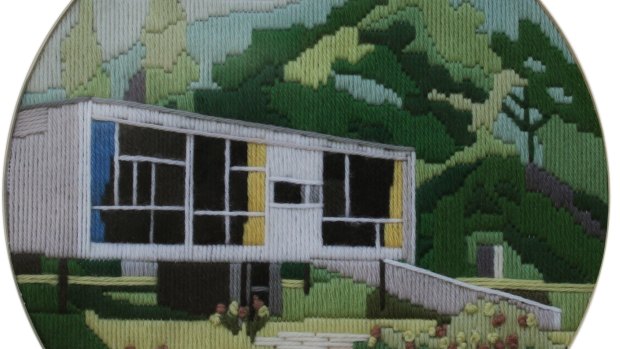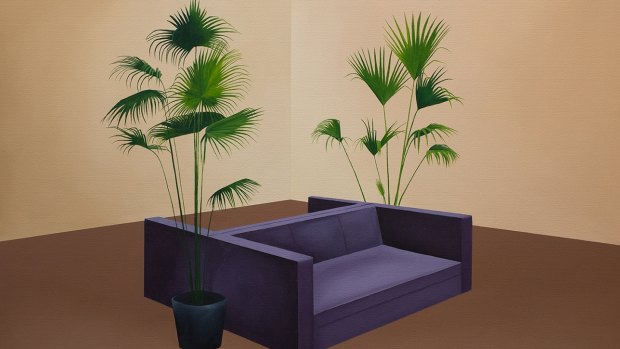This was published 7 years ago
Thoroughly Modern at Canberra Contemporary Art Space offers six views of modernism
By Peter Haynes
Thoroughly Modern. Various artists. Canberra Contemporary Art Space, Gorman Arts Centre. 55 Ainslie Avenue, Braddon. Until May 7.
Reviewer: Peter Haynes.

Matthew de Moiser's Rose Seidler House is one of four long-stitch embroidered images depicting modernist architecture. It is part of the Thoroughly Modern exhibition at Canberra Contemporary Art Space.
This is a handsome exhibition. The curator, David Broker, has garnered a collection of (mostly) strong visual statements. These stand autonomously, but also constitute substantial bases for his conceptual thesis as seen in the accompanying essay, and very effectively in the visual essay, Living the Dream, the latter as both text and ironic exhibition finale. Broker's exhibition is concerned with the way(s) his chosen contemporary artists confront, critique and express their interpretations of particularly modernist architecture. This is not necessarily about celebration, but rather more about intelligent and incisive discussion through the individual artworks.
In the Cube Space Danny Wild shows two digital videos. Individually these were clever and visually seductive. Around the Block is a high-keyed kaleidoscopic collage of suburban houses, streets, gardens, paths overlaid and intersecting in a mesmerising dance with themselves and the viewer. Common Memory is furnished with much the same imagery as Around the Block, but the repertoire is increased to include food, domestic tools, carpets, rubbish bins, bus stops and other elements of Australian suburbia. It too works like a kinetic collage, full of bright colour, but the efficacy of both is unfortunately undermined by their close placement and simultaneous running in the darkened Cube Space. There is an obvious dialogue going on between the two pieces but I found it difficult to "deal" with one while the other intruded visually and audibly.

Palm Down by Stephanie Wilson in Thoroughly Modern.
The architectural premise of Thoroughly Modern is given subversive domestic expression in Matthew de Moiser's Home Sweet Home, a group of four long-stitch embroidered images of iconic examples of modernist architecture made in 2010. The earliest is Le Corbusier's Villa Savoie (1931) and the most recent the Atherton Gardens Housing Estate in Melbourne (1960s). The artist has deployed found embroidery kits and an essentially domestic and female craft activity to produce high-end "kitsch" images of some of the most remarkable examples of what is referred to as the "International Style". These are clever commentaries full of interrogative irony. De Moiser's choice of "tool" speaks of the possibilities of bland repetition, a "quality" perhaps present in the proliferation of modernist architecture that characterised much of the urbanised world post-WW II and beyond.
De Moiser is represented by two further works – Without a Splash and Maser's Servo (first state), both from 2013. The artist's ironic stance is given bravura expression in these pieces made from the quintessentially 1950s and 1960s material for domestic interiors – Laminex. Here de Moiser uses almost garishly coloured sheets of Laminex to depict a suburban house and pool and an equally suburban local service station. Both works are given a veneer of elegant simplicity that speaks of the flat surface of modernist painting. The artistic allusion is also there in the title of Without a Splash, a tongue-in-cheek play with David Hockney's A Bigger Splash (1967), a painting that exemplifies the hedonistic lifestyle of 1960s Southern California. Maser's Servo (first state) recalls for me the deadpan images of Ed Ruscha, another artist of the Californian scene who like Hockney captures the surface whilst intimating the shallowness of what lies beneath. De Moiser's two bodies of work hold an intellectual, conceptual and aesthetic edge that, allied with a subtly interrogative stance, is intelligent, clever and visually appealing.
Alex Lewis shows a series of digital prints and an installation of "printed" concrete blocks. The eight prints (each 24 by 42 centimetres) are presented in a long line, adjoining one another. Each image is of a different type of design available in concrete bricks, a material that was/is ubiquitous in suburban architecture seen especially in screening walls, patios and the like. Lewis's prints are like the pattern books of the 18th- and 19th-centuries that provided the householder with beautifully made images of fabric design, cutlery, glassware, ceramics, furniture, everything necessary for the "modern" home. The images have a spare minimalist quality reinforced by the black-and-white (ish) palette. In his other works the artist uses actual concrete blocks decorated with photographic images of architectural details. These are physically accessible, displayed as a group installed on the gallery floor. The images on each brick provide identity as part of something else. Their combination alludes to that larger something whose enigmatic presence is evoked rather than expressed.
Stephanie Wilson's "peopleless" interiors are characterised by a pastel blandness that is curiously attractive. The empty spaces are starkly delineated; strict geometries of walls, floor and furniture broken only by the clinical insertion of indoor plants. The spaces pictured have an eerie quality that is nevertheless menacingly beautiful and simultaneously exudes a theatrical character like a set from a play waiting for the actors to fill it with life.

Grant Hill's Blue Gum Avenue depicts a quintessentially suburban Australian home.
Grant Hill's three works are imposing. Each is a 100 by 305 centimetres diptych. Individually and together they provide a powerful and compelling visual presence. Each depicts a quintessentially suburban Australian home. Each is given a title denoting the name of their street – variously Blue Gum Avenue, Blue Tongue Road and Stringy Bark Street. The works are made with earth pigments on timber and linen and the artist has capitalised on the various contrasting textures available to him through his choice of materials to produce especially effective images. The works also make no attempt to deny the structures that give them physical stability and coherence. Indeed those structures are purposefully visible and thus materials and process become integrated and essential components of the finished works. I noted that although the titles make reference to aspects of the natural environment I could not find a blue gum, a stringy bark or a lizard – maybe that's my floral and faunal ignorance, but their absence allied with the actual scale of Hill's works make pointed comments on the built environment's (modernist here) impact on the natural world.
Janet Angus's constructed wall pieces push out from the painterly surface into the viewer's space. Using an essentially dark palette the artist produces layered levels of anxious images that seem to emanate from the architectonic structures that form the basis of each work. The layers and the spaces in between them are metaphors for the anxieties experienced by those occupying the intrusive geometric harshness of Angus's constructed world. The artist's palette is another pointer to the mood that these works carry and for me it was most effective. However, I appreciated these works from a distance. Close examination lessened their impact for me. The visually intrusive means of presenting the thematic metaphor through actual layering diminished the conceptual and aesthetic edge that a more fully resolved two-dimensional surface might have produced.
David Broker's Living the Dream is derived from archival footage that celebrates "happy nuclear families, secure in work and building ideal lifestyles in the suburbs where everything was new and exciting" and that "reflects elements of each artist's work…visualising the social foundations of work that variously references a period when Australia came to identify itself as 'first world'". It is a pointed and clever finish to an exhibition that offers through the work of six artists intelligent, imaginative and aesthetically exciting contemporary ways of looking at the phenomenon of modernism.